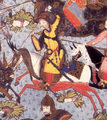Akinji
This article needs additional citations for verification. (June 2011) |
| Military of the Ottoman Empire |
|---|
 |

Akinji or akindji (
History
In war their main role was to act as advance troops on the front lines and demoralise the marching opposing army by using guerrilla tactics, and to put them in a state of confusion and shock.
Because of their mobility akinji were also used for reconnaissance and as a vanguard force to terrorize the local population before the advance of the main Ottoman forces. Since they were irregular militia, they were not bound by peace treaties, so they could raid border villages and attack enemy garrisons, fortresses and border posts during peacetime, constantly harassing the enemy and checking the weak spots on the rival country's defences. They would also attack trading routes to cut enemy's supply and transportation.
Akinji forces were led by certain families. Well-known akinji families were
Akindjis were gathered from mostly the Muslim population just as Devshirme was from the Christian population. However, there were exemptions for villages that were waqf lands. For example, in 1573, some villages in Filibe were exempted from giving akındjıs, since they were owned by the soup-kitchen waqf of the Sultan in Üsküdar.[3]
Since akinjis were seen as irregular militia, they did not have regular salaries as
The Akinji system had an important role at the establishment of the empire and fast expansion of Ottoman territories in Europe. Though the akinji system worked excellently from the 14th to 16th centuries, it began to decline after the 16th century. Starting with 16th-17th century nomadic
Although the terminology differentiating between similar types of Ottoman cavalry corps is not fully clarified, the akinji, once decimated in the battle of Giurgiu in October 1595 as they were retreating over the Danube, was apparently gradually replaced by new irregular corps, such as the "deli" and "bashi-bozouk".[4]
In literature
Akinji's lifestyle with battles was a romantic fantasy for the public. Therefore, akinjis were a popular subject in Ottoman folk literature and music. Serhad Türküleri (Border Folk Songs) is a subcategory of Ottoman folk music dealing mostly with akinji raids and battles or love affairs of akinji warriors, sometimes odes to fallen warriors. Alişimin Kaşları Kara (My Little Ali Has Black Eyebrows), and Estergon Kalesi (Castle of Esztergom) are some of the most popular examples. In the modern period, romantic-revivalist Turkish writers also wrote poems about akinjis. Yahya Kemal's Akıncılar is one of the most well-known example on this subject.
Gallery
-
An akinji irregular doing battle
-
Akinji duelling with Hungarian knight, Suleimanname
-
Akinji Sinan Bey duels with Hungarian knight Eugene, 1526, Suleymanname
-
Akinji Recruitment letter
See also
References
- ^ Moačanin, Nenad. "Matica hrvatska - Hrvatska revija 2, 2015. - Croato-Turcica: pregled povijesne interakcije Globalni okvir". www.matica.hr. Retrieved 2023-03-10.
Nositelji provala bili su uglavnom tzv. akindžije (tur. Akıncılar, »haratelji«, od akın, »bujica«; u njemačkim izvorima »Renner und Brenner«).
- ^ George F. Nafziger and Mark W. Walton. Islam at War: A History. p. 95.
- ISSN 0041-4255.
- ^ "Ottoman Turkish Uniforms WW1 History First World War Militaria Turkey Wargaming Military Insignia Uniform Crimea Crimean - Akinci Corps & Deli Cavalry (Janissary Period); 1860 Imperial Army Corps of Bashi-Bazouk". Ottoman Turkish Uniforms WW1 History First World War Militaria Turkey Wargaming Military Insignia Uniform Crimea Crimean. Archived from the original on 2015-01-23. Retrieved 2015-01-23.




